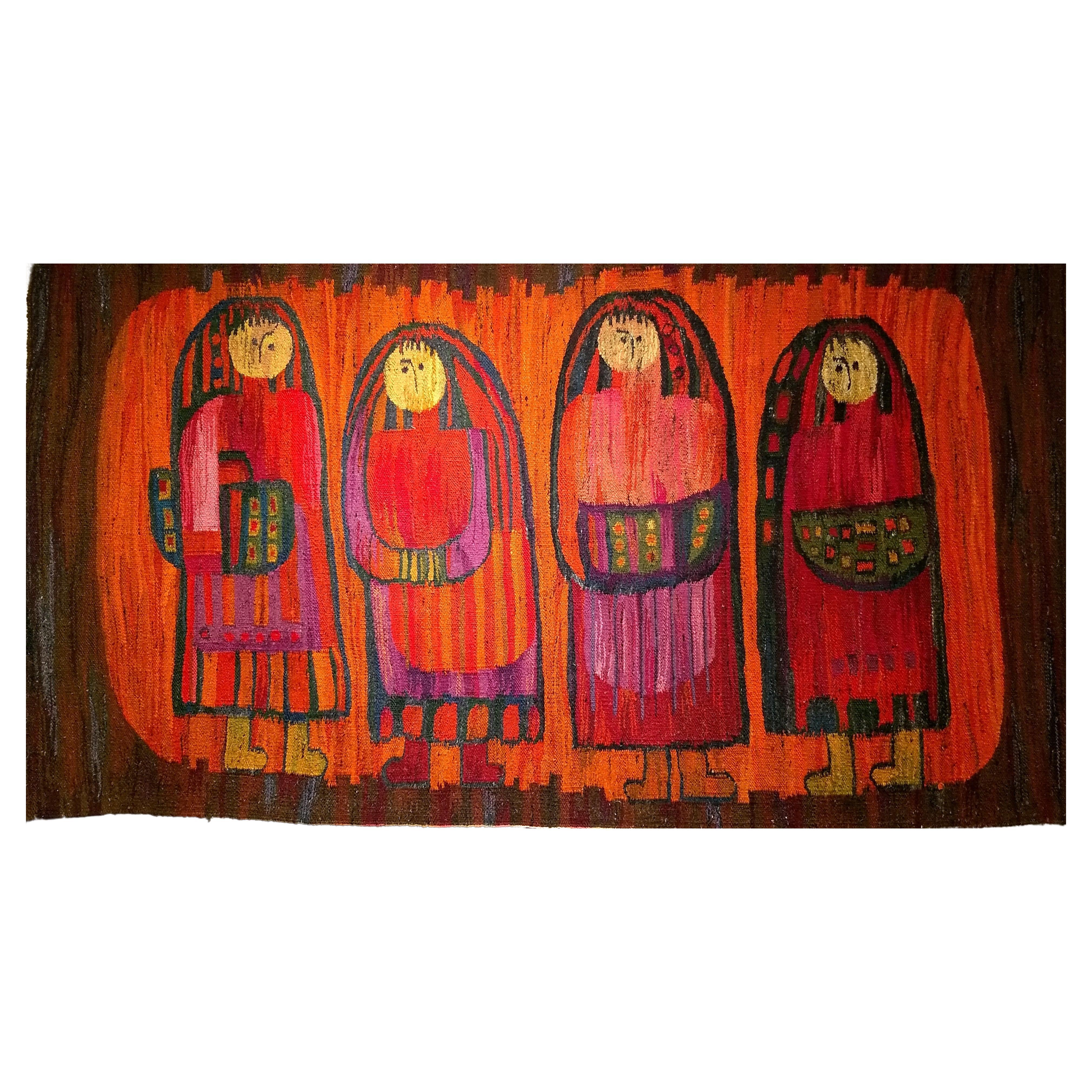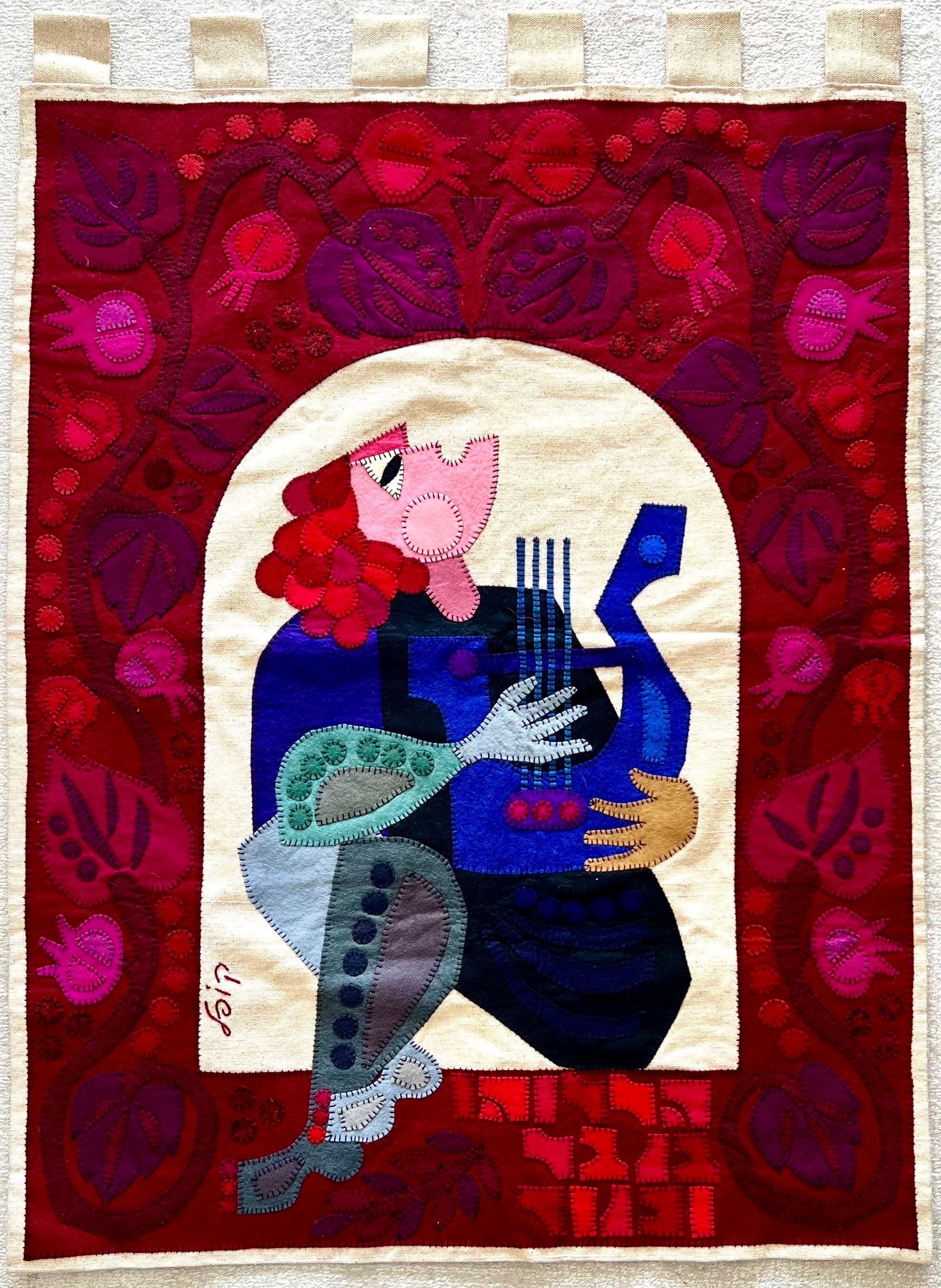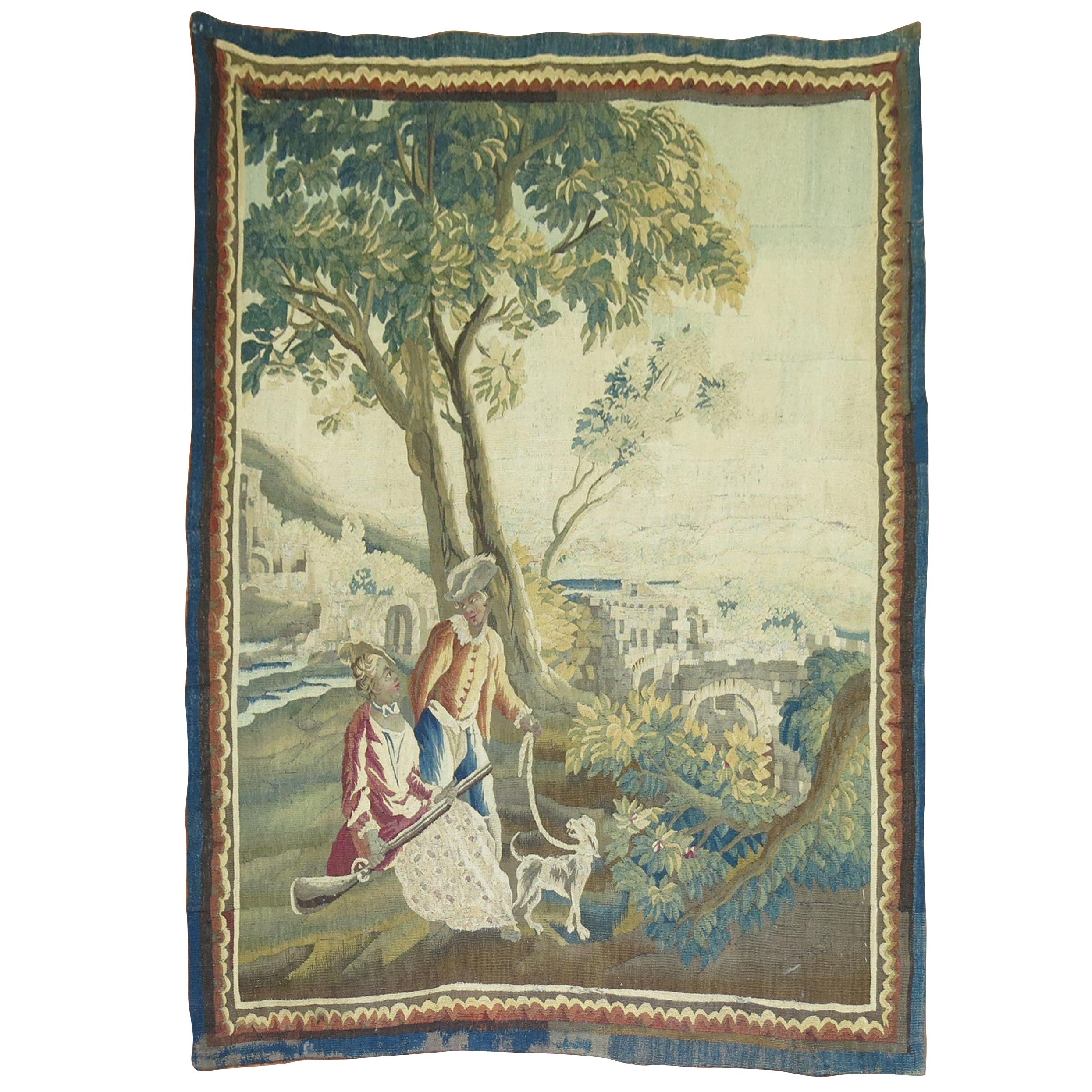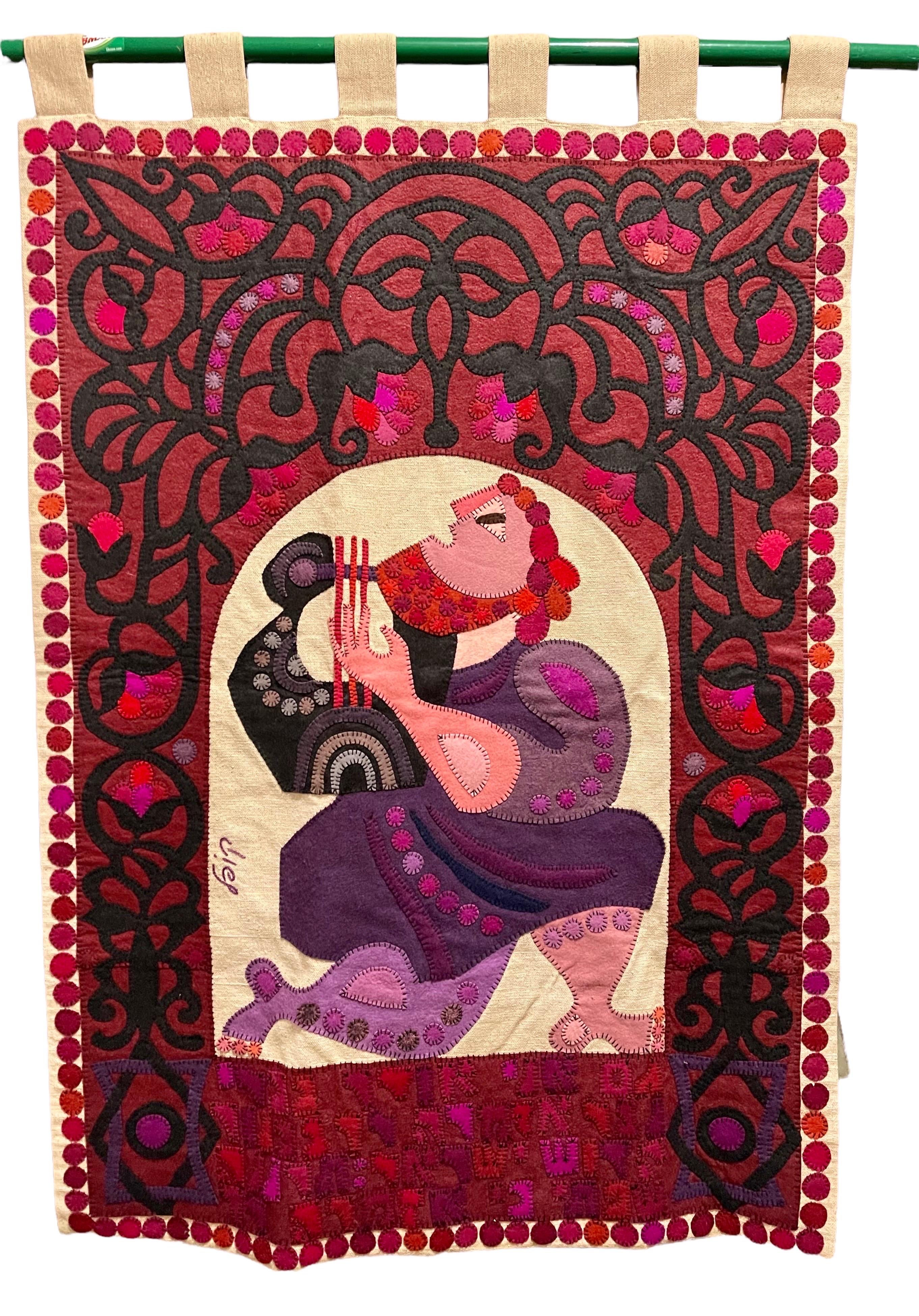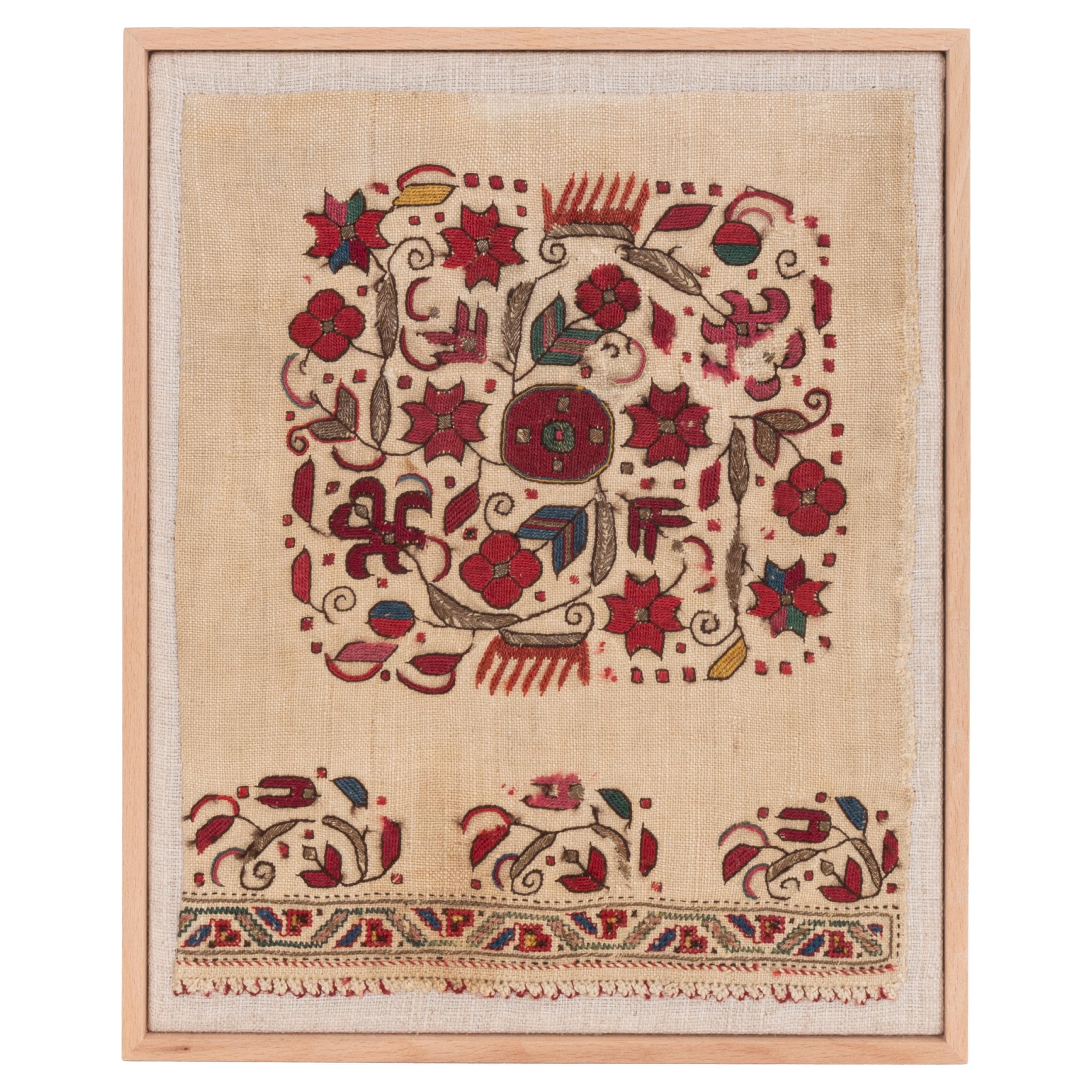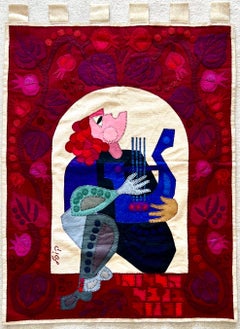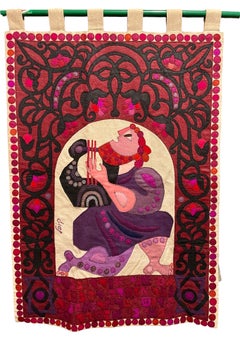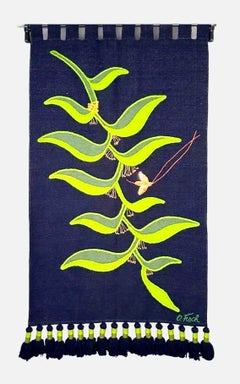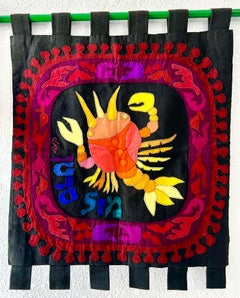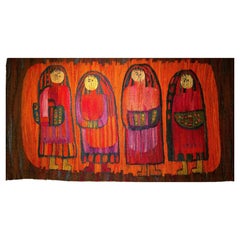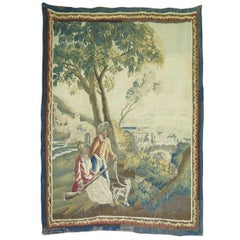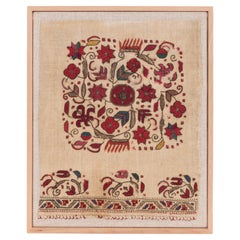Items Similar to Naive European French Folk Art Jovan Lazar Obican Tapestry Wall Hanging Weaving
Want more images or videos?
Request additional images or videos from the seller
1 of 17
Lazar ObicanNaive European French Folk Art Jovan Lazar Obican Tapestry Wall Hanging Weaving1968
1968
$950
£720.23
€830.24
CA$1,337.92
A$1,483.66
CHF 779.55
MX$18,127.77
NOK 9,753.26
SEK 9,155.10
DKK 6,197.87
About the Item
Lazar Obican 1944-2004
Tapestry, mixed media applique on woven background
Taking The Bird Away, Folk Art,
Dimensions: H 80 cm (32.25 in.) x W 58 cm (23in.)
The artist Lazar Obican iconic style is child-like yet masterfully adult; a style that tells a story with sociological overtones. His funny little people are always colorful, full of spirit, living with music and birds to bring them happiness. This is not an aubusson style but a pieced applique, quilt like style on a wool woven background. Mid century modern textile art.
Lazar Obican artist, painter, sculpture and mod mosaic ceramic artisan was born in Cannes, France, to his Yugoslavian family. He finished his training, imbued with the spirit of his native country, the people, their legends, and their philosophy. It has been said that his work has a "timeless quality" and a naive, folk art, outsider art brut quality, child-like primitive style. Obican is identified with his style the world over, a style that is simple yet sophisticated; child-like yet masterfully adult; a style that tells a story with psychological, philosophical or sociological overtones. His funny little people are always colorful, full of spirit, living with music and birds to bring them happiness. Best known for his depictions of folklore and traditional costumes rendered in a playful, childlike style and for his happy Jewish wedding scenes. He often used bright colors and black outlines in his renderings of figures and animals, giving his work an illustration-like quality. Thematically, the artist’s work is similar to Marc Chagall and Jean Dubuffet for its dreamlike images and so-called naïve style of painting. Over the course of his career, the artist maintained a studio in Boca Raton, Florida and Dubrovnik, Croatia—part of former Yugoslavia— where he developed an interest in Eastern Europe’s Jewish culture. Many of his mature works depict Jewish traditions and ceremonies, including traditional Jewish weddings, the dancing of the Hora, and traditional music. There is a display of his works in his former Dubrovnik studio.
His style is a unique conglomerate of tradition, history, legends, heroes, old customs and folklore. It is a self-standing style, recognizable, cheerful, whimsical and a happy creation. Naïve art is any form of visual art that is created by a person who lacks the formal education and training that a professional artist undergoes (in anatomy, art history, technique, perspective, ways of seeing). Unlike folk art, naïve art does not necessarily evince a distinct cultural context or tradition. Naïve art is recognized, and often imitated, for its childlike simplicity and frankness. Paintings of this kind typically have a flat rendering style with a rudimentary expression of perspective.
One particularly influential painter of "naïve art" was Henri Rousseau (1844–1910), a French Post-Impressionist who was discovered by Pablo Picasso. Naïve art is often seen as outsider art that is by someone without formal (or little) training or degree. While this was true before the twentieth century, there are now academies for naïve art. Naïve art is now a fully recognized art genre, represented in art galleries worldwide.
Museums devoted to naïve art now exist in Kecskemét, Hungary; Riga, Latvia; Jaen, Spain; Rio de Janeiro, Brasil; Vicq France and Paris. "Primitive art" is another term often applied to art by those without formal training, but is historically more often applied to work from certain cultures that have been judged socially or technologically "primitive" by Western academia, such as Native American, sub saharan African or Pacific Island art (see Tribal art). This is distinguished from the self-conscious, "primitive" inspired movement primitivism. Another term related to (but not completely synonymous with) naïve art is folk art. There also exist the terms "naïvism" and "primitivism" which are usually applied to professional painters working in the style of naïve art (like Paul Gauguin, Mikhail Larionov, Paul Klee).
At all events, naive art can be regarded as having occupied an "official" position in the annals of twentieth-century art since - at the very latest - the publication of the Der Blaue Reiter, an almanac in 1912. Wassily Kandinsky and Franz Marc, who brought out the almanac, presented 6 reproductions of paintings by le Douanier' Rousseau (Henri Rousseau), comparing them with other pictorial examples. However, most experts agree that the year that naive art was "discovered" was 1885, when the painter Paul Signac became aware of the talents of Henri Rousseau and set about organizing exhibitions of his work in a number of prestigious galleries. The Earth Group (Grupa Zemlja) were Croatian artists, architects and intellectuals active in Zagreb from 1929 to 1935. The group included the painters Krsto Hegedušić, Edo Kovačević, Omer Mujadžić, Kamilo Ružička, Ivan Tabaković, and Oton Postružnik, the sculptors Antun Augustinčić, Frano Kršinić, and the architect Drago Ibler. A term applied to Yugoslav (Croatian) naive painters working in or around the village of Hlebine, near the Hungarian border, from about 1930. Some of the best known naive artists are Dragan Gaži, Ivan Generalić, Josip Generalić, Krsto Hegedušić, Mijo Kovačić, Ivan Lacković-Croata, Franjo Mraz, Ivan Večenaj and Mirko Virius. Camille Bombois (1883–1970) Ferdinand Cheval, known as 'le facteur Cheval' (1836–1924) Henry Darger (1892–1973) L. S. Lowry (1887–1976) Grandma Moses, Anna Mary Robertson (1860–1961) Nikifor (1895–1968) Poland, Horace Pippin (1888–1946) Jon Serl (1894-1993) United States Alfred Wallis (1855–1942) Scottie Wilson (1890–1972) Gesner Abelard (b. 1922) Jan Balet (1913–2009) Michel Delacroix (b. 1933) France Howard Finster (1916–2001) Ivan Rabuzin (1921–2008)
Spontaneous Art Museum in Brussels
Art en Marge Museum in Brussels
MADmusée in Liege
International Museum of Naive Art of Brazil in Cosme Velho, Rio de Janeiro
Gallery Jacques Ardies in São Paulo
Musée international d'art naïf de Magog in Magog
Croatian Museum of Naïve Art in Zagreb
Gallery of Croatian Naïve Art in Zagreb
Croatian Naive Art Museum in Hlebine
Musée international d'Art naïf Anatole Jakovsky in Nice
Musée d'Art Naïf - Max Fourny in Paris
International Museum of Naive Art in Vicq (near Versailles)
Museum of Naive Art in Beraut (near Toulouse)
Museum Charlotte Zander in Bönnigheim
Gesellschaft für Naive Kunst in Hannover
Museum of Hungarian Naive Artists in Kecskemét
Gallery of International Naïve Art (GINA) in Tel Aviv
Naive Art Museum in Moscow
Collection of naïve and outsider art of Dr. X. Bogucharskaia and A.Turchin
Anthony Petullo Collection of Self-Taught & Outsider Art
American Visionary Art Museum in Baltimore, MD
His legion of fans and collectors include American presidents, senators, ambassadors, film stars and European nobility. His one man shows in New York City galleries were quite popular amongst the "Who's Who" of the time. Alfred Hitchcock bought seven of his works and Frank Sinatra, Stewart Granger and Mickey Rooney were among his many high profile patrons.
- Creator:Lazar Obican (French, Yugoslavian, American)
- Creation Year:1968
- Dimensions:Height: 32.25 in (81.92 cm)Width: 23 in (58.42 cm)
- Medium:
- Movement & Style:
- Period:
- Condition:
- Gallery Location:Surfside, FL
- Reference Number:1stDibs: LU38213722352
About the Seller
4.9
Platinum Seller
Premium sellers with a 4.7+ rating and 24-hour response times
Established in 1995
1stDibs seller since 2014
1,801 sales on 1stDibs
Typical response time: <1 hour
- ShippingRetrieving quote...Shipping from: Surfside, FL
- Return Policy
Authenticity Guarantee
In the unlikely event there’s an issue with an item’s authenticity, contact us within 1 year for a full refund. DetailsMoney-Back Guarantee
If your item is not as described, is damaged in transit, or does not arrive, contact us within 7 days for a full refund. Details24-Hour Cancellation
You have a 24-hour grace period in which to reconsider your purchase, with no questions asked.Vetted Professional Sellers
Our world-class sellers must adhere to strict standards for service and quality, maintaining the integrity of our listings.Price-Match Guarantee
If you find that a seller listed the same item for a lower price elsewhere, we’ll match it.Trusted Global Delivery
Our best-in-class carrier network provides specialized shipping options worldwide, including custom delivery.More From This Seller
View AllWool Felt Applique Israeli Folk Art Signed Tapestry Kopel Gurwin Bezalel School
By Kopel Gurwin
Located in Surfside, FL
This depicts KIng David reciting Psalms, Hallelujah in Hebrew
Kopel Gurwin (Hebrew: קופל גורבין) (1923–1990) was an Israeli tapestry wall hanging, painter and graphic artist.
Kopel (Kopke') Gurwin (Gurwitz) was born and raised in Vilna, the capital of Lithuania. He spoke Yiddish at home, but simultaneously studied Hebrew at their school which was part of the Tarbut educational network. Kopel was active in the Hashomer Hatzair youth movement. In the 1930s, as a teenager, Kopel helped his parents with the home finances by working in a suit workshop, there he first encountered the art of sewing.
With the outbreak of the Second World War and the German invasion of Vilna, the Jews were imprisoned in camps and ghettos. Kopel and his brother Moshe were separated from their parents and were put to work in coal mines and peat. Kopel's parents were taken to the Stutthof Nazi concentration camp where they died of typhus within a month of each other. Kopel's 12-year-old sister Chava was turned over to the Germans by a Polish family and murdered.
The brothers were arrested by the Germans, but were saved thanks to the connections of Nina Gerstein, Kopel's drama teacher. They hid in an attic until they were discovered, fled and moved to Riga, where they were caught and sent to the Stutthof concentration camp where they were imprisoned until the end of the war. They were put to work maintaining and cleaning trains and took part in one of the death marches. In July 1946, Kopel and Moshe sailed to Helsingborg, Sweden, as part of operation "Folke Bernadotte", in which Sweden took in ill survivors for rehabilitation. Once he recovered, Kopel worked in a publishing house and later was appointed director of the local branch of the Halutz movement.
In 1950 Kopel and Moshe made aliyah to Israel. Kopel worked as a survey for the Survey of Israel Company. In 1951, he enlisted to the Communication Corps and served as a military draftsman. There he won first prize for the design of the front cover of the Communication Corps bulletin.
With his discharge from the army at 29 he started studying drawing and graphics at the Bezalel Academy of Arts and Design in Jerusalem. Among his teachers were Isidor Ascheim, Shlomo Vitkin, Yossi Stern and Jacob Steinhardt. At the end of his first year of study, Kopel won the Reuben and Sarah Lif Excellence Award in written studies. During his studies he also won additional prizes: In 1956 he won first prize from the Lethem Foundation in California for poster design. Later the same year, Kopel won the Hermann Struck prize for his drawing on the theme of Jerusalem.
In 1957 he won an additional first prize from the Lethem Foundation and second place from the printing company Ortzel for a drawing for a Jewish New Year greeting card. In 1958 he won first prize in a competition to design a poster for Tel Aviv's jubilee.
Two years later he won three other awards: First and third prize for designing a poster for Israel Independence Day, celebrating 12 years of the State of Israel.
Also that year Kopel won first prize for a poster to mark the 25th Zionist Congress.
In 1964 he entered the Independence Day poster competition on the theme of aliyah and won first and second prize. Four years later he again entered the competition on the theme of 20 years of Israel's independence and won first prize. The poster was styled like a Holy Ark curtain with two lions and a menorah at its centre. This poster appeared on the cover of the famous book Jewish Art and Civilization, edited by Geoffrey Wigoder as well as the record Voices of 20 Years, 1948-1968, edited by Yossi Godard. In April 1971 he won first prize in the Independence Day poster competition for the fourth time.
Kopel's Folk Art tapestry won the Israeli Independence Day Poster Contest in 1968
With the completion of his studies at Bezalel Kopel moved to Tel Aviv and was hired by Shmuel Grundman's graphics and design studio. Grundman took him to Europe with him to design and supervise the construction of Israeli exhibition pavilions. During his time at Grundman's he discovered the fibrous felt from which he produced most of his wall hangings. At the 1964 Levant Fair exhibition he used felt stuck onto wooden panels for the first time.
The first felt wall hanging that Kopel produced was intended for the American Cultural Centre in Jerusalem and its theme was the United States Declaration of Independence. The wall hanging, which measured 2.85 X 1.85 meters, was stuck on a wooden panel. Kopel ordered rolls of felt from France and began work on wall hangings based on bible stories. He used a needle, hand sewing small even stitches with black embroidery thread which framed and highlighted every detail in the work, as well as using appliqué. The interior designer, Alufa Koljer-Elem, introduced him to Ruth Dayan who managed the shop Maskit in September 1967 he opened his first solo exhibition at the Maskit 6 gallery, in which 12 wall hangings were displayed.
In light of the exhibition at Maskit 6, Meira Gera, the director of artistic activity at the America-Israel Cultural Foundation, organized an additional exhibition of his works at the foundation's exhibition hall in New York City. The exhibition sparked immense press interest, and was also displayed for a few months at the New York Jewish Museum, from where it travelled throughout the United States.
Followed by the exhibition at the Delson-Richter gallery in Old Jaffa, which was later also exhibited at the Jerusalem Theatre.
Kopel's tapestry "The Time for Singing has Arrived" was printed on a UNICEF greeting card in 1978 and again in 1981.
The Israeli Philatelic Service issued three stamps based on three of Kopel's holy ark curtains and one stamp based on an Independence Day poster he designed.
Kopel's creations decorate a large number of synagogues, public buildings, hotels and private collections which were purchased in Israel and around the world. They have decorated, among others, the walls of the King David Hotel in Jerusalem, the VIP room at Ben Gurion Airport, the Kfar Saba theatre and the Plaza Hotel in Tel Aviv.
Israel has had a Vibrant Folk Art, Naive art scene for a long time now artists like Israel Paldi, Nahum Guttman, Reuven Rubin had naive periods. The most well know of the strict naive artists are Shalom of Safed, David Sharir, Irene Awret, Gabriel Cohen, Natan Heber, Michael Falk and Kopel Gurwin.
Exhibitions:
1995 The Knesset Jerusalem
1988 Temple Beth Shalom Miami, Florida
1988 University of Jewish Studies Los Angeles
1987 Israel Congregation on the Northern Coast Chicago
1985 Jerusalem Theatre Jerusalem
1984 Tenafly New Jersey
1983 Horace Richter Gallery Old Jaffa
1974 Jerusalem Theatre Jerusalem
1974 Delson Richter Gallery Old Jaffa
1972 University of Jewish Studies Miami, Florida
1971 Jewish Museum New York
1970 Norman Gallery Canada
1970 Sharei Tzedek Congregation Winnipeg, Canada
1970 Gallery of the Year Los Angeles
1970 Gallery of the Year Scottsdale
1969 Gleeman Gallery Chicago
1969 Israel Congregation of the Northern Coast Chicago
1967 Maskit 6 Tel Aviv
Prizes:
1971 First Independence Day poster 1971, 23 yeaes of the State of Israel
1969 Second International Tel Aviv poster...
Category
20th Century Folk Art Mixed Media
Materials
Wool, Felt
Wool Felt Craft Applique Vintage Israeli Judaica Folk Art Tapestry Kopel Gurwin
By Kopel Gurwin
Located in Surfside, FL
This depicts King David playing the harp, along with a verse in Hebrew from the Psalms. all made by hand. woven and stitched. Vintage, original piece.
Kopel Gurwin (Hebrew: קופל גור...
Category
20th Century Folk Art Mixed Media
Materials
Wool, Felt
Vintage Handwoven Tapestry Wool Folk Art Rug Weaving Wall Hanging Olga Fisch
By Olga Fisch
Located in Surfside, FL
Olga Fisch ( American 1901-1990)
Hummingbird and Pendant Flower, hand woven and stitched wool and sequins, signed lower right.
Dimensions: 58 x 32 in.
Olga Fisch was born in Hungary, studied in Germany and lived in Morocco and Ethiopia before receiving asylum as a Jewish refugee in Ecuador in 1939. For her Indian-inspired designs, Mrs. Fisch uses natural black and white sheep...
Category
20th Century Folk Art More Art
Materials
Wool
Wool Felt Applique Israeli Folk Art Signed Tapestry Kopel Gurwin Bezalel School
By Kopel Gurwin
Located in Surfside, FL
This depicts a Crab, In Hebrew Mazel Sartan (the Zodiac symbol Cancer, June-July) all made by hand. woven and stitched.
Kopel Gurwin (Hebrew: קופל גורבין) (1923–1990) was an Israeli tapestry wall hanging, painter and graphic artist.
Kopel (Kopke') Gurwin (Gurwitz) was born and raised in Vilna, the capital of Lithuania. He spoke Yiddish at home, but simultaneously studied Hebrew at their school which was part of the Tarbut educational network. Kopel was active in the Hashomer Hatzair youth movement. In the 1930s, as a teenager, Kopel helped his parents with the home finances by working in a suit workshop, there he first encountered the art of sewing.
With the outbreak of the Second World War and the German invasion of Vilna, the Jews were imprisoned in camps and ghettos. Kopel and his brother Moshe were separated from their parents and were put to work in coal mines and peat. Kopel's parents were taken to the Stutthof Nazi concentration camp where they died of typhus within a month of each other. Kopel's 12-year-old sister Chava was turned over to the Germans by a Polish family and murdered.
The brothers were arrested by the Germans, but were saved thanks to the connections of Nina Gerstein, Kopel's drama teacher. They hid in an attic until they were discovered, fled and moved to Riga, where they were caught and sent to the Stutthof concentration camp where they were imprisoned until the end of the war. They were put to work maintaining and cleaning trains and took part in one of the death marches. In July 1946, Kopel and Moshe sailed to Helsingborg, Sweden, as part of operation "Folke Bernadotte", in which Sweden took in ill survivors for rehabilitation. Once he recovered, Kopel worked in a publishing house and later was appointed director of the local branch of the Halutz movement.
In 1950 Kopel and Moshe made aliyah to Israel. Kopel worked as a survey for the Survey of Israel Company. In 1951, he enlisted to the Communication Corps and served as a military draftsman. There he won first prize for the design of the front cover of the Communication Corps bulletin.
With his discharge from the army at 29 he started studying drawing and graphics at the Bezalel Academy of Arts and Design in Jerusalem. Among his teachers were Isidor Ascheim, Shlomo Vitkin, Yossi Stern and Jacob Steinhardt. At the end of his first year of study, Kopel won the Reuben and Sarah Lif Excellence Award in written studies. During his studies he also won additional prizes: In 1956 he won first prize from the Lethem Foundation in California for poster design. Later the same year, Kopel won the Hermann Struck prize for his drawing on the theme of Jerusalem.
In 1957 he won an additional first prize from the Lethem Foundation and second place from the printing company Ortzel for a drawing for a Jewish New Year greeting card. In 1958 he won first prize in a competition to design a poster for Tel Aviv's jubilee.
Two years later he won three other awards: First and third prize for designing a poster for Israel Independence Day, celebrating 12 years of the State of Israel.
Also that year Kopel won first prize for a poster to mark the 25th Zionist Congress.
In 1964 he entered the Independence Day poster competition on the theme of aliyah and won first and second prize. Four years later he again entered the competition on the theme of 20 years of Israel's independence and won first prize. The poster was styled like a Holy Ark curtain with two lions and a menorah at its centre. This poster appeared on the cover of the famous book Jewish Art and Civilization, edited by Geoffrey Wigoder as well as the record Voices of 20 Years, 1948-1968, edited by Yossi Godard. In April 1971 he won first prize in the Independence Day poster competition for the fourth time.
Kopel's Folk Art tapestry won the Israeli Independence Day Poster Contest in 1968
With the completion of his studies at Bezalel Kopel moved to Tel Aviv and was hired by Shmuel Grundman's graphics and design studio. Grundman took him to Europe with him to design and supervise the construction of Israeli exhibition pavilions. During his time at Grundman's he discovered the fibrous felt from which he produced most of his wall hangings. At the 1964 Levant Fair exhibition he used felt stuck onto wooden panels for the first time.
The first felt wall hanging that Kopel produced was intended for the American Cultural Centre in Jerusalem and its theme was the United States Declaration of Independence. The wall hanging, which measured 2.85 X 1.85 meters, was stuck on a wooden panel. Kopel ordered rolls of felt from France and began work on wall hangings based on bible stories. He used a needle, hand sewing small even stitches with black embroidery thread which framed and highlighted every detail in the work, as well as using appliqué. The interior designer, Alufa Koljer-Elem, introduced him to Ruth Dayan who managed the shop Maskit in September 1967 he opened his first solo exhibition at the Maskit 6 gallery, in which 12 wall hangings were displayed.
In light of the exhibition at Maskit 6, Meira Gera, the director of artistic activity at the America-Israel Cultural Foundation, organized an additional exhibition of his works at the foundation's exhibition hall in New York City. The exhibition sparked immense press interest, and was also displayed for a few months at the New York Jewish Museum, from where it travelled throughout the United States.
Followed by the exhibition at the Delson-Richter gallery in Old Jaffa, which was later also exhibited at the Jerusalem Theatre.
Kopel's tapestry "The Time for Singing has Arrived" was printed on a UNICEF greeting card in 1978 and again in 1981.
The Israeli Philatelic Service issued three stamps based on three of Kopel's holy ark curtains and one stamp based on an Independence Day poster he designed.
Kopel's creations decorate a large number of synagogues, public buildings, hotels and private collections which were purchased in Israel and around the world. They have decorated, among others, the walls of the King David...
Category
20th Century Folk Art Mixed Media
Materials
Wool, Felt
Israeli Bird and Fish Hand Woven Itche Mambush Atelier Aubusson Style Tapestry
By Sami Briss
Located in Surfside, FL
This is an Aubusson style flat weave hand woven wool tapestry. This is from the Itche Mambush workshop. it is edition 2/5 (He worked with Mordechai Ardon, Marcel Janco, Abraham Rattner and others inspired By Jean Lurcat and Jean Picard...
Category
20th Century Folk Art More Art
Materials
Mixed Media
Jerusalem Wall Hanging Hand Embroidered tapestry Israeli Craft Judaica Folk Art
By Esther BenSimon
Located in Surfside, FL
This is an artistic weaving depicting the old city of Jerusalem. Signed in Hebrew and dated verso. it is all Hand Woven.
Esther Bensimon is a native of Argentina. She graduated from the Teacher’s College of Yeshiva University in New York City and immigrated to Israel in 1968. She is held in high regard as both an artist and a human being. Perpetually fascinated by the world of art, Esther Bensimon originally fulfilled her yearning to become a part of it by weaving magnificent wall hangings. She was accepted, early in her career, as a member of The House of Quality, the prestigious Jerusalem artist cooperative where she opened her first studio. It is a prestigious venue with sculpture by David Palombo and artists studios Zelig Segal, Ori Resheff, Avi Biran, Menachem Berman...
Category
1980s Folk Art Mixed Media
Materials
Wool, Cotton
You May Also Like
Mid-Century Folkloric Tapestry of Four Schoolgirls in Traditional Dress
Located in Barrington, IL
This vibrant mid-century handwoven tapestry captures a charming folkloric scene of four schoolgirls dressed in traditional attire, brought to life through a radiant palette of autumnal hues—crimson, golden yellow, burnt orange, and soft lavender. Rich in texture and emotion, the tapestry exudes warmth, storytelling, and nostalgia, making it a captivating example of vintage textile art.
Reminiscent of Marc Chagall’s dreamlike murals at the Metropolitan Opera House, the composition masterfully balances expressive color with whimsical charm. Each figure is rendered with a poetic mix of abstraction and detail, lending the piece visual movement and emotional resonance.
This one-of-a-kind artisan wall hanging is a perfect statement piece for mid-century modern interiors, folk art collections, or textile art galleries. A rare fusion of craftsmanship, imagination, and vintage soul—ideal for collectors, designers, and those drawn to narrative art with a timeless feel.
Dimensions: 38" x 70"
Date of Manufacture: 3rd Quarter of the 1900s
Place of Origin: Europe
Material: Wool
Condition: Excellent
The Persian Knot Gallery, SKU 1733
mid-century tapestry, vintage handwoven wall art...
Category
Mid-20th Century Baltic Tapestries
Materials
Wool, Cotton
Zabihi Collection Antique French Tapestry
Located in New York, NY
Authentic 18th-century tapestry
5'4'' x 6'9''.
Category
Antique 18th Century French Folk Art Tapestries
Materials
Wool
Little Turkoman Susani Tapestry for Table or Wall
Located in Alessandria, Piemonte
Unusual Little size for this embroidered Susani, elegant and suitable for wall tapestry - fine, simple, elegant -
B/2411.
Category
1990s Turkmen Other Tapestries
Materials
Cotton, Silk
Professionally Framed Antique East European Embroidery, 19th C.
Located in Istanbul, TR
First the fragment has been hand backed on a linen fabric, then stretched over a wooden stretcher and finished with a wooden frame.
Late 19th C. Bulgaria.
Ready to go on a wall.
Fra...
Category
Antique Late 19th Century Bulgarian Folk Art Decorative Art
Materials
Silk
French artistic wall tapestry signed and dated 1977
Located in L’ISLE-SUR-LA-SORGUE, FR
French wall tapestry from 1977, hand-woven by the artist using a variety of materials such as jute, cotton and wool.
An artistry showcasing a stunning blend of shades and textures.
...
Category
Vintage 1970s French Mid-Century Modern Tapestries
Materials
Wool, Jute, Cotton
Antique French Tapestry Handwoven French Tapestry Verdure Scenic Tapestry
Located in New York, NY
Rare Antique French Tapestry Pictorial Woodsman Verdure 1920 Tapestry Large Tapestry Wall Hanging 5'2" x 6'8" 5 x 7 153cm x 204cm
circa 1920
"Thi...
Category
Vintage 1920s French Tapestries
Materials
Wool
More Ways To Browse
French Folk Art
Tapestry Wall Hanging
Wall Art Weaving
Vintage Adult Art
Eastern European Artists
Wool Art Wall Hanging
Croatia Art
Tapestry Flat Weave
Naive Folk Art
Jewish Wall Art
African Primitive Art
Picasso Tapestry
African American Folk Art Painting
Vintage Florida Wall Art
Hanging Ceramic Wall Art
French Primitive Paintings
Primitive Folk Art Paintings
Howard Post Painting
